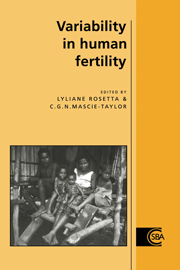Book contents
- Frontmatter
- Contents
- List of contributors
- 1 Introduction: the biological anthropological approach
- PART I HORMONAL ASPECTS OF FERTILITY REGULATION
- PART II INTERPOPULATION VARIABILITY
- PART III METABOLIC AND ENERGETIC ASPECTS OF REGULATION
- 8 Metabolic adaptation in humans: does it occur?
- 9 Possible adaptive mechanisms for energy saving during physical activity
- 10 Body composition and fertility: methodological considerations
- 11 Breast-feeding practices and other metabolic loads affecting human reproduction
- Index
8 - Metabolic adaptation in humans: does it occur?
Published online by Cambridge University Press: 03 February 2010
- Frontmatter
- Contents
- List of contributors
- 1 Introduction: the biological anthropological approach
- PART I HORMONAL ASPECTS OF FERTILITY REGULATION
- PART II INTERPOPULATION VARIABILITY
- PART III METABOLIC AND ENERGETIC ASPECTS OF REGULATION
- 8 Metabolic adaptation in humans: does it occur?
- 9 Possible adaptive mechanisms for energy saving during physical activity
- 10 Body composition and fertility: methodological considerations
- 11 Breast-feeding practices and other metabolic loads affecting human reproduction
- Index
Summary
Introduction
An adaptive response is an inevitable consequence of sustained perturbation in the environment and may be genetic, physiological and or behavioural. They are not completely separate entities as they interact with each other at several levels and are not without cost to the organism. Every adaptation has its cost and there is no such thing as a ‘ costless ’ adaptation. The processes and the costs involved may be: overt or covert, reversible or irreversible and transient or permanent. An adaptive response is a homeostatic response. However, the term ‘ homeostasis ’ pertains to maintenance of the constancy of the internal milieu when changes occur within the acceptable range of physiological variability. A sustained perturbation in any one direction will result in responses which will further the survival of the individual and help maintain homeostasis but at a cost to the organism. A homeostatic response may neither have additional costs to the organisms nor lead to compromise in its function, capability, or performance, while an adaptive response may do both in order to further the survival of the individual. Adaptation is a relatively slow process and should be distinguished from the rapid regulatory role of homeostatic mechanisms.
Adaptations in energy metabolism of humans
It has been suggested that the energy metabolism of individuals is more variable and adaptable than previously believed, and that allowances need to be made for this when arriving at estimates of human energy requirements.
- Type
- Chapter
- Information
- Variability in Human Fertility , pp. 125 - 147Publisher: Cambridge University PressPrint publication year: 1996
- 5
- Cited by



